Respectful Pruning Improves Grapevine Development: A Case Study in Young Vineyards
Abstract
Grapevine pruning is an agronomical operation required to regulate growth and yield, improve fruit quality, and maintain plant health and vigour. However, the intensification of the crop in the last decades, driven by efforts to increase productivity and decrease costs, has led to reduced attention to this operation. The aim of this study was to investigate whether different pruning styles during the first years of vineyard training affect grapevine development. Three pruning styles were followed in a newly planted cv. “Tempranillo” vineyard for four consecutive pruning seasons: (i) respectful (RESP), where pruning cuts were always made leaving protection wood between the cut and vine perennial structures, and the preferential sap flow path was chosen; (ii) aggressive (AGGR), where no protection wood was left and, when possible, the nonpreferential sap flow path was followed; and (iii) winegrape grower (WIN), where the common practices used in the area were followed, which corresponds to an intermediate style between RESP and AGGR. In general, the RESP style increased the vegetative development compared to WIN and AGGR styles over the years and produced a higher yield in the first production year, although the intensity of the effect was not the same in the two vineyards considered. This was the first effort to systematically assess the effects of respectful pruning techniques on vine vegetative growth and demonstrate scientifically its impact.
1. Introduction
Pruning is an agronomical operation required by most deciduous agricultural species to regulate growth and yield, improve fruit size and quality, and maintain plant health and vigour [1]. In the case of grapevines, pruning has been historically considered one of the most important operations for successful growth. In fact, Columella, the most prominent writer on agriculture in the Roman Empire, highlighted in his masterpiece De Re Rustica that pruning is the most necessary among the operations that we should apply in the vineyard. In the early 20th century, viticulturists such as [2, 3] also emphasized that the utmost attention should be given to grapevine pruning in order to maintain a productive, healthy, and long-lasting crop. However, in the second half of the 20th century, the focus in mainstream viticulture moved toward increasing productivity and reducing costs, leading to a decreased attention to pruning practices [4, 5].
There has been a concurrence between the changes mentioned above in grape growing and the widespread appearance of symptoms of decline in new vineyards [6]. Although it is not easy to establish a direct link between the two, vineyard decline is likely associated with many biotic and abiotic stresses [7, 8], which can increase the harmful potential of the fungi responsible for grapevine trunk diseases (GTD). In this context, careless pruning, based upon an oversimplification of its physiological driving principles (continuity of sap flow, wound size, and distance to vine perennial structures), is thought to be one of the salient factors that have made vineyards more prone to develop GTD. In fact, although there is not much scientific research supporting the link between the type of pruning and the incidence of wood diseases, some authors have already observed an increase in Eutypa incidence as the total cut surface area per vine increases [9]. Consequently, a renewed interest in pruning has arisen, with an increased number of specific books and guides on grapevine pruning having been published [10–12], and private and public consultancy and courses have arisen in grape-growing regions worldwide. These authors advocate for growers to adopt “gentle” or “respectful” pruning techniques to enhance the productivity and longevity of their vineyards while minimizing vine decline.
The operational procedures associated with “respectful” pruning are multiple and not easy to summarize, but they stand on two main principles: (i) to minimize pruning wound size and keep a good distance from pruning cut and perennial vine structures (trunk, arms, and spurs) and (ii) to maintain a morphology that facilitates continuous sap flow, hypothesized to prevent the “hydraulic isolation” of regions within the vine [5, 13, 14].
The first principle (minimizing wound size and increasing their distance to vine perennial structures) is based upon the knowledge on the physiological response to pruning cuts. Grapevine, as most lianas, responds to cuts by occluding xylem vessels with gels or tyloses that limit dehydration of the tissues and pathogen attack [15–17].
This healing process leads to the formation of a desiccation cone, whose depth is estimated on average as 1.5 times the diameter of the wound [18], and has been demonstrated to be a useful tool to reduce, at least in some varieties, the proportion of necrosis left above the diaphragm in one year cuts and to reduce the impact of necrotic damage at the diaphragm level [19]. In any case, the cuts made in canes in close proximity to perennial structures or in older wood can therefore hinder sap flow if the desiccation cone associated with the wound gets inside its conductive vessels [20, 21]. The number and surface of pruning wounds and the pruning date have already been associated with the infectivity, incidence, and severity of GTDs in grapevines [9, 22].
The second principle of “respectful” pruning (continuity of sap flow) is also linked to grapevine particular characteristics as a liana. Grapevine xylem shows a remarkable degree of functional hydraulic sectoring, and water flows predominantly in discrete sections [23]. In grapevine shoots, each node bears a single leaf, following an alternate distichous phyllotaxis along the shoots [24]. Within the stem secondary anatomy, vascular structures are established according to two longitudinal alignments along parallel axes (orthotics) that divide the stem into two halves that remain relatively independent [25]. Probably, as a consequence of this fact, most training systems that have been used for centuries in many grape-growing areas, such as the big family of gobelet variants across the Mediterranean growing areas, kouloura in Santorini, and vara y pulgar in Jerez, isolate the position of the pruning wounds only on one side of the arms so as to minimize sap-flow disruption [26]. Rather, on the contrary, pruning cuts placed in opposite positions within a trunk, arm, or spur have been observationally associated with its premature aging and subsequent death [2, 5, 14] and with decreased xylem conductance [20].
Although all those “gentle” or “respectful” pruning principles are based upon a wide corpus of empirical observations, there is little systematic research supporting them. The aim of this work is to evaluate the impact of pruning styles that differ in their degree of compliance with those principles and their effect on vine development. In our approach, newly planted vineyards have been considered to avoid the bias that previous pruning practices might cause, allowing us to study the implications of three pruning styles during the first four years of plant development.
2. Material and Methods
2.1. Plant Material, Growth Conditions, and Training Scheme
Experiments were conducted in two vineyards located in the North of Spain, planted in 2019 with Tempranillo grafted onto Richter 110, the same year the experiment started. One of the fields (Vineyard #1) was located in Murieta (Navarra, Spain, 42.663N, −2.157W), whereas the second one (Vineyard #2) was in El Cortijo (La Rioja, Spain, 42.492N, −2.520W).
Vineyard #1 plant spacing was 3.0 m × 1.2 m, and a drip irrigation system with self-balancing emitters of 4 L·h−1 placed every 0.75 m along a single drip pipe was installed shortly after planting. The soil at the site was glacis-type quaternary sedimentary soil with a loamy texture and 9% active lime, was highly calcareous, and had relatively high fertility (2.74% organic matter). Vineyard #2 was planted at a spacing of 2.8 m × 1.2 m; no irrigation system was available, and the soil was a quaternary terrace of the Ebro River, with a sandy loamy texture, calcareous but with poor active lime (4%), and low organic matter (0.86%). In both locations, the cordon wire was located 0.75 m above the soil, and rows and interrows were tilled mechanically to reduce the competition of adventitious vegetation.
Both vineyards have Mediterranean climate with warm summers and cool winters. Weather data recorded during trials in Vineyards #1 and #2 are shown in Supplementary Figure 1. The average annual temperature was around 12.7°C, and the total rainfall per year is around 600 mm for Vineyard #1 (Figure S1A). On the other hand, the vineyard located in Vineyard #2 has a slightly warmer climate with an average annual temperature of 13.9°C, and the total rainfall per year is around 481 mm (Supplementary Figure 1B).
Both vineyards were designed to be trained as a spur-pruned bilateral cordon, with the same training schedule, procedure, and timing detailed in Figure 1. In short, in May 19, grafted dormant plants were planted, and no green pruning was carried out on the shoots that emerged during the first year. In December 19, the plants were pruned to a single 2-bud spur. In 2020, the main objective was to form the trunk of the vine. To do so, in May 20, a single shoot per plant was retained after green pruning, and in December 20, this cane was finally positioned to form the central trunk. In 2021, the objective was to form the two arms of the vine. In the spring, shoots in excess were removed through green pruning to keep 3 to 5 shoots per plant (depending on vigour), and in the winter, two of those canes were selected to form the arms, and the rest were eliminated. Lastly, the objective in 2022 was to select the spurs on the arms of the vine. In May 22, shoot thinning was used to keep 3 shoots per arm at an approximate distance of 17–20 cm, and in December 22, these canes were pruned to 2 buds each to form the spurs.
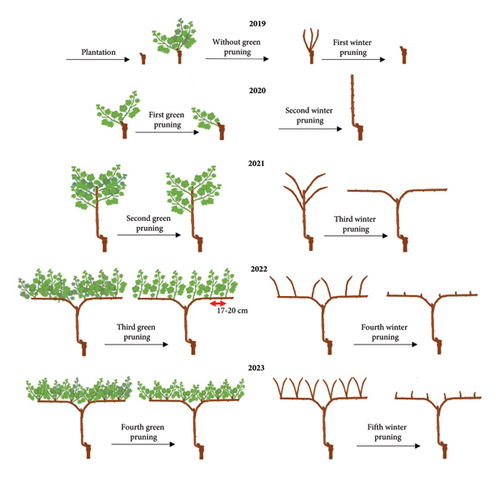
2.2. Experimental Design
The experimental design used was similar in the two vineyards. Three pruning styles were compared, following a complete randomized design with three blocks. The three pruning styles compared differed in the criteria for performing pruning cuts and attention to xylem flow continuity, implying different degrees of compliance with the respectful pruning principles described in the previous section. In short (details provided below), the pruning styles compared were as follows: (i) respectful (RESP), where pruning cuts were always made leaving a portion of internode wood ≥1.5 times longer than the diameter of the cut, and the preferential sap flow path was chosen, positioning wounds on the same side to compartmentalize the wound effects; (ii) aggressive (AGGR), where no stub was left at cane shortening and very flat cuts were made for cane removal, the cuts being made without maintaining even the crown buds, and when possible, the nonpreferential sap flow path was followed; and (iii) winegrape grower (WIN), where the common practices used in the area were followed, which corresponds to an intermediate style between RESP and AGGR, leaving an internode wood 0.7–1.0 times the diameter of the cut and not applying any criterion on sap paths. In Vineyard #1, all the experimental measurements in each of the three blocks were made on 7 plants, while 20 vines per block were considered in Vineyard #2, totalling 21 and 60 vines per treatment. To verify that there was no a priori difference between the plants that were to be included in the experiment that could bias future results, the winter prior to applying the first pruning (Dec 19), the sum of the cane cross-sectional area (CCSA) was estimated for each vine by using a digital calliper (CD67-S15PP, Mitutoyo Corp., Japan), measuring two orthogonal diameters, and assuming a circular shoot section. No differences were found (p ≥ 0.05).
These pruning styles required different operation procedures depending on the year and time of the season, and differences between treatments were established at 5 key points in their training process. After the first growing season, the first dormant pruning was conducted (December 19). As detailed in Figure 1, plants were pruned back to a two-bud spur, the cuts being more or less aggressive according to the criteria of each treatment (Figure 2), prioritizing sap flow and distance between the cut and the pruning wound in RESP vines, performing the cuts close to the future trunk, not paying attention to sap flow but to cane verticality in AGGR, and promoting verticality (i.e., not selecting the cane to form the spur looking at sap flow path continuity), but keeping the crown buds upon cane removal in WIN. During the next spring (May 20), green pruning consisted of shoot removal aimed at leaving one single shoot per plant. In RESP plants, the shoot that followed best in preferential sap flow was kept, despite not being the most vertical, whereas in AGGR the opposite was chosen, being slightly more aggressive in cut performance (Figure 3). Regarding WIN treatment, the shoot kept was the straightest one, since growers usually consider that this choice will ease the training of the trunk in the following winter.
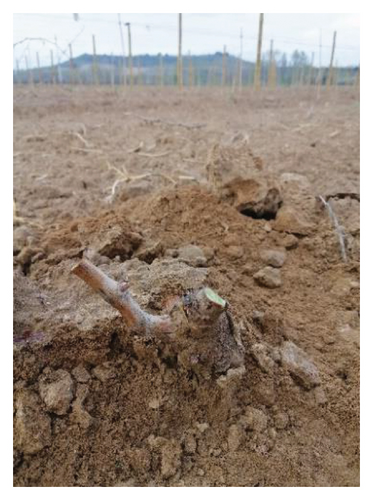
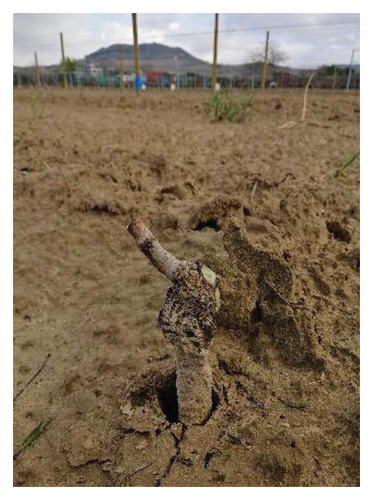
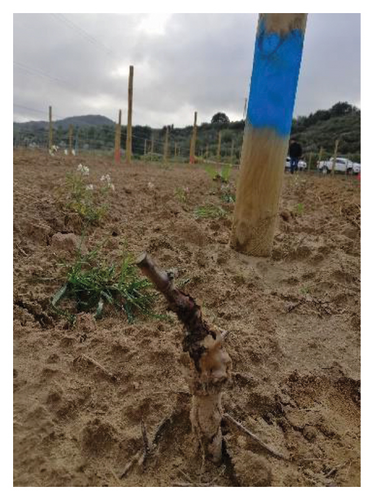
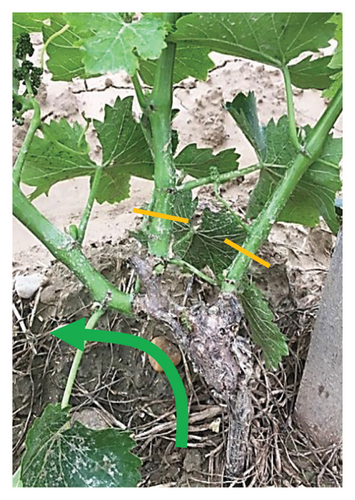
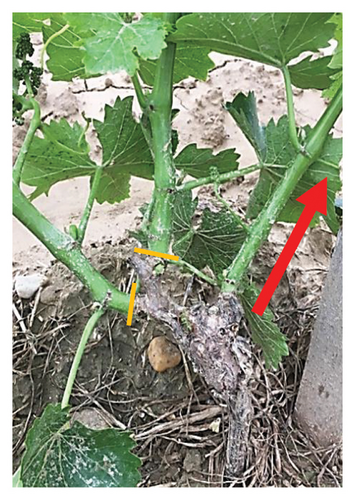
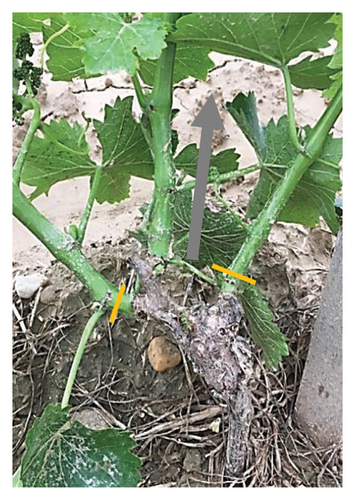
Next winter (December 20), in the second dormant pruning, the trunk was formed, and the only difference between treatments was the distance between the cuts made to remove canes (mainly laterals) and the cane that was selected as the future trunk (Figure 4). No differential strategies were applied in green pruning during the following spring. In the third dormant pruning (December 21), where the two canes that were to constitute the future arms were selected and pruned, differences between treatments were the length of the stubs left upon lateral removal (Figure 4). In the next pruning (May 22), shoot removal was performed equally in all pruning strategies, leaving three shoots per arm. Finally, in the fourth dormant pruning (December 22), the canes that would become the future spurs were pruned to two buds, with differences in the distance between the cuts and the perennial strategies depending on the treatment.
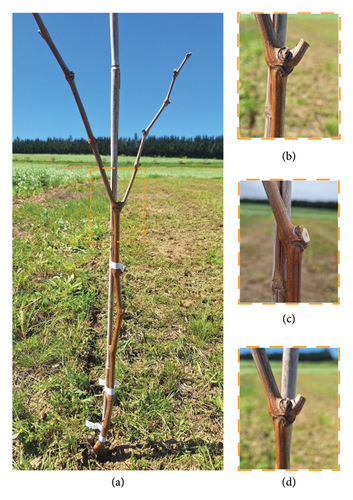
2.3. Measurements of Vine Development
Vine development was evaluated through the measurement of their vegetative growth. Although, during the vine training process, there are no reference values sought by growers, provided sufficient cane vigour is achieved to complete training at the desired pace, we can consider vegetative growth a proxy of vine total growth and health status. Vegetative growth was measured each season before dormant pruning, counting the number of canes and measuring their individual diameter with a digital calliper (CD67-S15PP, Mitutoyo Corp., Japan). The cane diameter was measured at the middle part of the internode between the first two buds at the base of each cane. These values were used to calculate the mean and total cane cross-sectional area (CCSA) for each vine as a surrogate of vine growth [27]. Then, pruning was performed, and the fresh weight was measured with a field dynamometer (ILSA 9702, Sint-Pieters-Leeuw, Belgium). These measurements are considered complementary since CCSA integrates the development of all the canes (removed or not during winter pruning), while pruning weight only accounts for the canes that were removed.
Concerning spring pruning, each season the number of shoots removed was counted, and their weight was determined. At the end of the three seasons, both pruning mass and SCSA were calculated as cumulative values by adding them for each treatment and vineyard. In the harvest of 2022, bunches per vine were counted and weighted, and yield was calculated. Then, the Ravaz index, a widely used crop load index, was calculated as the ratio between yield and pruning mass per vine.
2.4. Statistical Analysis
The statistical analysis of the data was conducted with R Studio version 4.3.0 (RStudio: Integrated Development for R., Boston, MA, United States) for Windows. Data were subjected to the Kolmogorov–Smirnov normality test and the Levene test to guarantee their homoscedasticity. After guaranteeing that the data followed the requirements, an analysis of variance (ANOVA) was applied to determine significant differences between the different pruning strategies. For all data, means ± standard errors (SE) were calculated, and when the F value was significant (p ≤ 0.05), a post hoc Tukey HSD test was executed using the “agricolae” 1.2–8 R package [28].
3. Results
The effect of the treatments on growth after the first season was similar in both vineyards (Table 1). There was no difference between the number of canes per vine that ranged between 1 and 2. However, in both sites, cane size was higher in RESP vines, which showed increased mean and total CCSA and cane and total pruning weight compared to AGGR and WIN vines. Thus, a greater vigour was observed when the cuts were performed according to RESP pruning criteria.
| Seasonal vegetative development | Winter pruning | ||||
|---|---|---|---|---|---|
| Cane number | Total CCSA (mm2) | Mean CCSA (mm2) | Pruning weight (g) | Mean cane weight (g) | |
| Vineyard #1 | |||||
| RESP | 1.47 ± 0.32 | 381.8 ± 0.2a | 282.8 ± 29.2a | 318.8 ± 30.4a | 256.8 ± 21.5a |
| AGGR | 1.33 ± 0.18 | 171.3 ± 0.2b | 126.2 ± 14.5b | 142.7 ± 10.8b | 124.8 ± 9.2b |
| WIN | 2.00 ± 0.24 | 226.8 ± 0.2b | 132.3 ± 11.5b | 185.7 ± 19.6b | 111.1 ± 0.7b |
| p value | ns | ∗∗ | ∗∗∗ | ∗∗∗ | ∗∗∗ |
| Vineyard #2 | |||||
| RESP | 1.29 ± 0.07 | 256.1 ± 12.8a | 217.5 ± 11.4a | 362.8 ± 25.4a | 313.8 ± 21.6a |
| AGGR | 1.22 ± 0.08 | 190.4 ± 9.2b | 170.3 ± 8.8b | 242.4 ± 15.9b | 229.7 ± 15.1b |
| WIN | 1.15 ± 0.06 | 199.6 ± 9.4ab | 189.7 ± 9.1b | 244.9 ± 13.7b | 233.8 ± 14.1b |
| p value | ns | ∗∗∗ | ∗∗ | ∗∗∗ | ∗∗∗ |
- Values are means ± EE (n = 3–20) separated by the post hoc Tukey HDS test (p ≤ 0.05). Within columns, different letters indicate significant differences between the pruning styles. ns indicates no significance. ∗∗, ∗∗∗Significance at 1% and 0.1% probability levels, respectively. RESP: respectful pruning with cuts made with protective wood (1.5 times the diameter of the cut) and attention to the sap flow; AGGR: aggressive pruning where cuts were made without protective wood or attention to the sap flow; WIN: cuts performed following the criteria of the winegrape growers of the area, without attention to the sap flow and leaving less than 1.5 times the diameter of the cut as protective wood.
Several differences in vine growth were also associated with the pruning style used during the second season (Table 2). During the green pruning, pruning style did not affect either the number of shoots removed or their size, but a greater total SCSA was observed in RESP and AGGR vines in Vineyard #1. A similar trend was reported in Vineyard #2, where RESP pruning showed the greatest values for total and mean SCSA, although differences with AGGR pruning were not statistically significant. Growth evaluation performed through winter pruning parameters also showed that RESP pruning increased pruning mass in Vineyard #1, but no differences were observed in Vineyard #2.
| Green pruning | Seasonal vegetative development | Winter pruning | ||||||
|---|---|---|---|---|---|---|---|---|
| Removed shoot no. | Pruning mass (g) | Mean shoot mass (g) | Cane number | Total CCSA (mm2) | Mean CCSA (mm2) | Pruning mass (g) | Mean cane mass (g) | |
| Vineyard #1 | ||||||||
| RESP | 9.68 ± 0.92 | 93.64 ± 8.15 | 10.11 ± 0.89 | 5.54 ± 0.58 | 422.6 ± 33.1a | 79.71 ± 3.5 | 373.1 ± 35.3a | 72.83 ± 6.56a |
| AGGR | 9.11 ± 0.56 | 84.00 ± 6.71 | 9.31 ± 0.72 | 5.58 ± 0.38 | 379.5 ± 31.5a | 68.96 ± 5.0 | 220.8 ± 18.9b | 41.33 ± 4.60b |
| WIN | 8.65 ± 0.73 | 97.68 ± 6.23 | 11.44 ± 0.89 | 4.40 ± 0.37 | 291.3 ± 27.7b | 67.59 ± 5.2 | 213.3 ± 18.1b | 47.43 ± 3.96b |
| p value | ns | ns | ns | ns | ∗ | ns | ∗∗∗ | ∗∗∗ |
| Vineyard #2 | ||||||||
| RESP | 8.52 ± 0.28 | 244.6 ± 11.77 | 28.77 ± 1.12 | 5.07 ± 0.11 | 604.6 ± 20.9a | 120.1 ± 3.6a | 572.62 ± 29.9 | 113.09 ± 5.25 |
| AGGR | 8.02 ± 0.33 | 220.3 ± 9.58 | 28.08 ± 0.96 | 4.80 ± 0.11 | 555.9 ± 18.0ab | 116.7 ± 3.5ab | 545.29 ± 25.2 | 115.34 ± 5.88 |
| WIN | 7.83 ± 0.29 | 222.6 ± 11.21 | 28.22 ± 1.06 | 5.00 ± 0.08 | 542.3 ± 17.9b | 108.6 ± 3.1b | 513.70 ± 27.4 | 102.57 ± 5.53 |
| p value | ns | ns | ns | ns | ∗ | ∗ | ns | ns |
- Values are means ± EE (n = 3–10) separated by the Tukey HDS posthoc test (p ≤ 0.05). Within columns, different letters indicate significant differences between the pruning styles. ns indicates no significance. ∗, ∗∗∗Significance at 5% and 0.1% probability levels, respectively. RESP: respectful pruning with cuts made with protective wood (1.5 times the diameter of the cut) and attention to the sap flow; AGGR: aggressive pruning where cuts were made without protective wood or attention to the sap flow; WIN: cuts performed following the criteria of the winegrape growers of the area, without attention to the sap flow and leaving less than 1.5 times the diameter of the cut as protective wood.
During the third season, the pruning style also affected vine vegetative growth (Table 3). Thus, during the green pruning, increased shoot number and the mass of removed shoots were observed in RESP vines compared to AGGR and WIN in Vineyard#1. Cane development during this season was also affected by the pruning style in Vineyard #1, where CCSA in RESP vines was higher than that in AGGR vines, a similar trend being observed in Vineyard #2, although differences were not significant. These trends were confirmed by winter pruning data, for which in both vineyards the pruning mass of RESP vines was greater than that of AGGR or WIN vines. This season was the first one where the vines produced a crop, confirming the growth trend observed up to that point through production data (Table 4). RESP pruning style increased yield compared to AGGR and WIN, although the effect was significant only in Vineyard #1. There were no differences in crop load, estimated as the Ravaz index, between the three pruning treatments. In adult vineyards, Ravaz index values between 5 and 9 are considered to be indicative of adequate vine balance, but in our study conditions, mean values around 1.34 in Vineyard #1 and 3.63 in Vineyard #2 correspond to differences in their shoot fertility (average of ≈0.4 vs. 1.6) associated with greater vegetative development and cane weight in Vineyard #2. Whereas bunch no. per shoot in Vineyard #2 reached what can be considered normal for this variety in this region, and those in Vineyard #1 are far below what can be expected in an adult vine. No differences in bunch number per shoot were observed between treatments.
| Green pruning | Seasonal vegetative development | Winter pruning | ||||||
|---|---|---|---|---|---|---|---|---|
| Removed shoot no. | Pruning mass (g) | Mean shoot mass (g) | Cane number | Total CCSA (mm2) | Mean CCSA (mm2) | Pruning mass (g) | Mean cane mass (g) | |
| Vineyard #1 | ||||||||
| RESP | 15.65 ± 0.80a | 371.6 ± 31.4a | 24.03 ± 1.95 | 7.10 ± 0.55 | 519.6 ± 46.8a | 72.94 ± 3.64 | 335.0 ± 41.7a | 45.28 ± 4.49a |
| AGGR | 12.45 ± 0.75b | 235.7 ± 24.1b | 18.42 ± 1.27 | 6.11 ± 0.35 | 355.6 ± 28.4b | 57.76 ± 2.85 | 184.2 ± 28.4b | 30.03 ± 4.21b |
| WIN | 11.58 ± 1.15b | 258.9 ± 33.5b | 22.34 ± 2.17 | 6.11 ± 0.45 | 391.6 ± 33.4ab | 67.06 ± 6.57 | 202.8 ± 37.8b | 33.50 ± 6.45b |
| p value | ∗∗ | ∗∗ | ns | ns | ∗∗ | ns | ∗∗ | ∗ |
| Vineyard #2 | ||||||||
| RESP | 12.80 ± 0.49a | 592.6 ± 28.2 | 47.28 ± 2.31 | 6.10 ± 0.63 | 1264.4 ± 168.3 | 209.63 ± 24.83 | 758.3 ± 167.5a | 127.79 ± 7.91 |
| AGGR | 11.65 ± 0.43b | 576.5 ± 28.7 | 49.27 ± 1.69 | 5.95 ± 0.55 | 1229.0 ± 202.7 | 210.73 ± 33.10 | 658.3 ± 124.2ab | 113.17 ± 8.04 |
| WIN | 10.74 ± 0.51b | 526.0 ± 30.6 | 49.52 ± 1.90 | 5.93 ± 0.65 | 1200.6 ± 185.4 | 207.52 ± 32.26 | 628.9 ± 50.4b | 108.56 ± 10.31 |
| p value | ∗∗ | ns | ns | ns | ns | ns | ∗ | ns |
- Values are means ± EE (n = 3–10) separated by the post hoc Tukey HDS test (p ≤ 0.05). Within columns, different letters indicate significant differences between the pruning styles. ns indicates no significance. ∗, ∗∗Significance at 5% and 1% probability levels, respectively. RESP: respectful pruning with cuts made with protective wood (1.5 times the diameter of the cut) and attention to the sap flow; AGGR: aggressive pruning where cuts were made without protective wood or attention to the sap flow; WIN: cuts performed following the criteria of the winegrape growers of the area, without attention to the sap flow and leaving less than 1.5 times the diameter of the cut as protective wood.
| Pruning style | Yield (g/vine) | No. of bunches (vine) | No. of bunches (shoot) | Bunch weight (g) | Ravaz index |
|---|---|---|---|---|---|
| Vineyard #1 | |||||
| RESP | 310 ± 49a | 3.35 ± 0.49 | 0.57 ± 0.41 | 108.13 ± 24.86 | 1.52 ± 0.58 |
| AGGR | 192 ± 37ab | 2.72 ± 0.4 | 0.48 ± 0.32 | 64.86 ± 8.65 | 1.75 ± 0.58 |
| WIN | 134 ± 32b | 1.81 ± 0.26 | 0.24 ± 0.19 | 67.45 ± 6.93 | 0.76 ± 0.16 |
| p value | ∗ | ns | ns | ns | ns |
| Vineyard #2 | |||||
| RESP | 2,521 ± 206 | 9.92 ± 0.36 | 1.64 ± 0.42 | 250.95 ± 20.47 | 3.90 ± 0.37 |
| AGGR | 1,906 ± 105 | 9.85 ± 0.37 | 1.67 ± 0.47 | 187.86 ± 7.02 | 3.27 ± 0.22 |
| WIN | 2,357 ± 431 | 9.12 ± 0.42 | 1.55 ± 0.51 | 212.4 ± 23.74 | 3.74 ± 0.46 |
| p value | ns | ns | ns | ns | ns |
- Values are means ± EE (n = 3–10) separated by the post hoc Tukey HDS test (p ≤ 0.05). Within columns, different letters indicate significant differences between the pruning styles. ns indicates no significance. ∗Significance at 5%. RESP: respectful pruning with cuts made with protective wood (1.5 times the diameter of the cut) and attention to the sap flow; AGGR: aggressive pruning where cuts were made without protective wood or attention to the sap flow; WIN: cuts performed following the criteria of the winegrape growers of the area, without attention to the sap flow and leaving less than 1.5 times the diameter of the cut as protective wood.
Globally, as the previous results indicated, the pruning style caused a relevant effect on vine vegetative development, an effect that can be clearly observed when cumulative CCSA and winter pruning weight were calculated (Figure 5). Thus, we found that cumulative CCSA and winter pruning weight were significantly increased in vines subjected to the RESP style compared to the other two styles (with the exception of TCSA in Vineyard #2). However, no clear difference was observed between AGGR and WIN pruning styles. The differences in yield mirrored the differences in accumulated cane size and reinforced the hypothesis that respectful pruning styles result in better vine functioning, allowing them to allocate more biomass in both vegetative and reproductive organs.
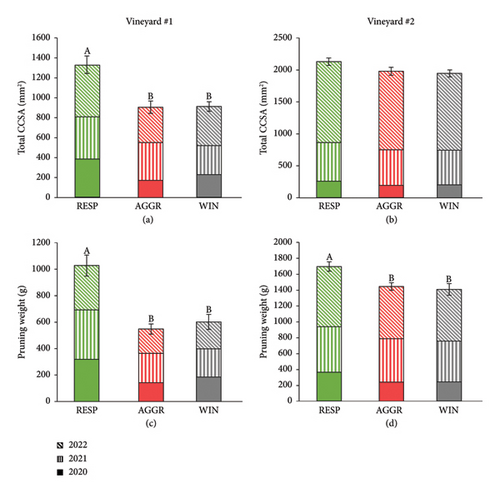
4. Discussion
This study aimed to assess the impact of different pruning styles on vine development through systematic compliance with the principles of “gentle” or “respectful” pruning. Globally, our results showed that a respectful pruning style accounted for increased vegetative growth (i.e., total and mean CCSA, pruning weight, and mean cane weight) compared to the more aggressive pruning styles (AGGR and WIN), although the differences at the more vigorous site were more subtle and not always significant. This positive effect was cumulative and resulted in a greater yield in the first production year.
In mature vineyards, it is known that performing cuts in canes during the winter pruning leads to the development of a drying cone towards the interior that will be larger when the diameter of the wound is greater [21], being able to hinder the sap flow [10]. The presence of this necrotic wood in permanent parts of the grapevine can translate into potentially harmful effects for them, such as the partial obstruction of the vascular system [17, 29]. It is reasonable to hypothesize that this harmful effect can be more relevant in young plants when the perennial structures of the vine are built. The negative effects of a desiccation cone may depend on the diameter of the removed structure, its location in the plant, the proximity in which the pruning cuts are made into canes, and the age of the removed wood structure during pruning [11]. Under our experimental procedure, we did not monitor the wound sizes; however, we showed a clear and cumulative impact of the more aggressive pruning styles (WIN and AGGR) on the grapevine growth over the years. This might be explained by the fact that after winter pruning and during the growing season, tyloses and gels start to develop quickly in the xylem close to the wound; thus, xylem vessel occlusion is a critical response to wounding injuries and might lead to the occlusion of about 85% of the vessels [15]. In fact, a recent work shows that vines pruned without considering the sap flow pathways had a 40-to-50% less conductive sap flow than vines pruned adopting the sap pathway respect criteria [20]. In addition, it is well-established that the consequence of leaving a portion of the wood when removing canes could lead to the development of the basal buds, which will require some extra work by removing these growing shoots in spring [5], increasing the weight of shoot removal in accordance with our study. “Respectful” pruning recommends leaving these buds since their presence can limit the extension of the necrotic wood [21].
Additionally, our results highlighted that vine vigour may modify the impact of pruning styles. Thus, we found that RESP pruning increased pruning weight and mean cane weight in Vineyard #1, but no differences between pruning styles were observed in Vineyard #2 during the second year of monitoring. This inconsistency between vineyards can be explained by the different vine vigours found, given that it is well established that under limiting conditions, nutrient uptake and biomass adaptation though xylem sap are enhanced in less vigorous grapevines [30]. Contrarily, in Vineyard #1, with a lower vigour, vines were more responsive to respectful pruning practices.
It is worth mentioning that no differences between AGGR and WIN styles were generally recorded under our experimental conditions. Since the differences between these two treatments were mainly related to stub length and differed less in terms of respecting or not respecting sap flow pathways, we can hypothesize that the latter has a more predominant role in impacting grapevine development over the first few years. However, aggressively performed wounds and not leaving protection wood might lead to poorer development in the midterm due to a higher incidence of diseases [9, 22], although this fact has not been fully demonstrated to date.
Winegrape growers are aware that insufficiently meticulous pruning increases grapevine decline, whereas pruning that does not interfere with sap flow and vigour limitation practices may limit decline occurrence [31]. Accordingly, this work showed that the interruption of the sap flow by more aggressive pruning strategies accounted for decreasing growth during the first years of vineyard establishment. Although our results cannot be directly transferred to adult vine conditions and specific trials would be necessary to obtain solid conclusions, we can hypothesize that some of these principles may apply to spur or cane structures in adult vines. However, empirical observations on the relevance of applying respectful pruning principles are still required.
5. Conclusion
To the best of our knowledge, this work constitutes the first systematic assessment of the effects of respectful pruning techniques on vine vegetative growth compared to more aggressive practices in vineyards during the first years of a vineyard establishment. Different pruning criteria resulted in variations in the grapevine’s vegetative growth, leading to differences in shoot growth and canopy development. Thus, we found that the RESP pruning style during the first 3 years of vineyard establishment accounted for increased vegetative growth over the three years of experimentation. This systematic protocol may allow us to identify midterm implications of the pruning style on vineyard performance and also determine if carryover implications are maintained over the years, affecting longevity and vine health status in the medium to long term.
Conflicts of Interest
The authors declare that they have no conflicts of interest.
Acknowledgments
This work has been carried out within the EFA324/19 VITES QUALITAS and EFA033/01 VITRES projects. Both are part of POCTEFA, a European cross-border cooperation program, created to promote the sustainable development of the border area between Spain, France, and Andorra (POCTEFA 2014–2020 and POCTEFA 2021–2027, respectively). These projects aim to increase the longevity and health of vineyards through the evaluation and implementation of plant production and pruning practices. Both projects have been cofinanced at 65% by the European Regional Development Fund (ERDF) through the Interreg V-A Spain-France-Andorra program. M. Galar is a beneficiary of a predoctoral contract of the Public University of Navarra (ref. 871/2023). A. Villa-Llop is a beneficiary of an industrial predoctoral contract of the Government of Navarra (ref. 283E/2020). N. Torres acknowledges the postdoctoral grant RYC2021-034586-I funded by MCIN/AEI/10.13039/501100011033 and “European Union Next Generation EU/PRTR”. Open access funding provided by Universidad Pública de Navarra. The authors want to thank Dr. Dylan Grigg for his critical reading of the manuscript.
Open Research
Data Availability
The data used to support the findings of this study are available from the corresponding author upon request.




